BenQ XL2720T Gaming Monitor Reviewed
by Chris Heinonen on June 17, 2013 4:35 PM ESTOur second calibration target is designed for print work, with a light output of 80 nits instead of 200 nits, and the sRGB gamma curve instead of the 2.2 Power Curve.
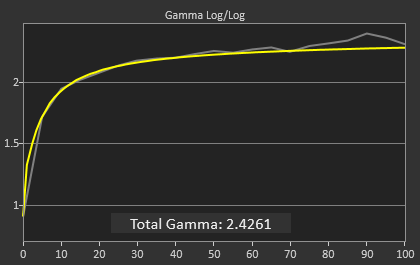
The grayscale continues to be excellent, even better than with the first calibration but you wouldn’t be able to tell even if they were side-by-side. There is a bit of a spike in the gamma that keeps it from being perfect, but even that spike doesn’t cause the dE2000 to rise at all. The biggest problem is that the contrast ratio has fallen down to 488:1 from the prior 820:1 level. Possibly the LED backlight doesn’t dim enough for the darkest settings, or the maximum light output was still too high and the LUTs had to be heavily lowered, either of which will cause a loss of contrast ratio. That issue aside, the grayscale calibration is very good.
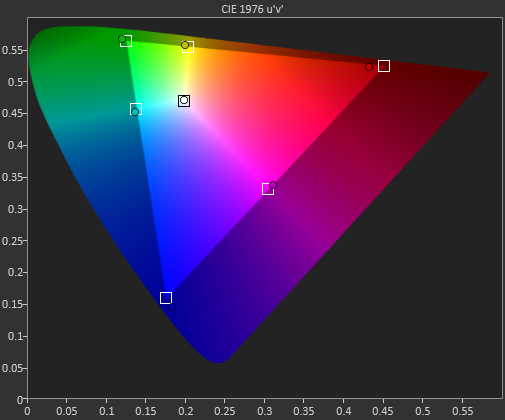
Color gamut is almost identical to at 200 nits. Too low of luminance in green, too little saturation in red, otherwise pretty good.
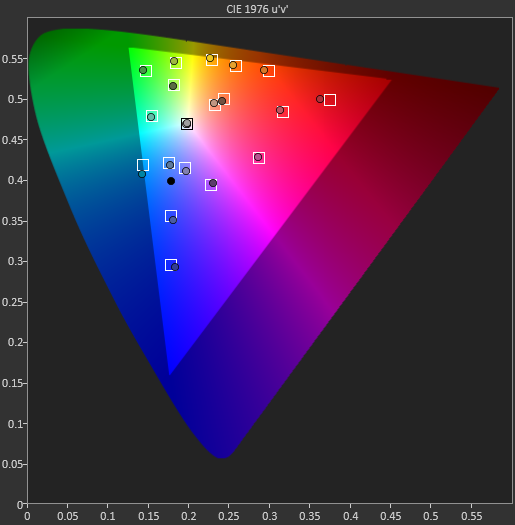
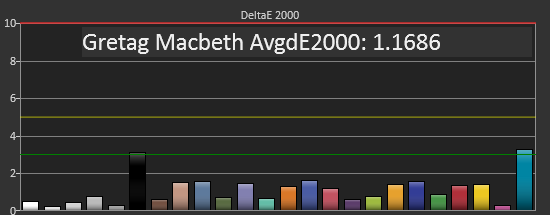

The colorchecker data here really surprises me. The yellow-orange shades that have been causing us such issues are no longer a problem. Now that shade of blue that lies on the edge of the sRGB target is causing the issue. I imagine the blue issue is related to the lack of green luminance, which affects cyan shades because of that. At lower light output levels, the error level in blue readings can be higher, since their light output is low to begin with, and if the green component is low in luminance, that can cause a much larger drop in the light output, leading to a larger error. Looking at the DeltaL chart for this measurement shows that it is quite low in luminance, which is almost certainly causing most of that color error. As to why orange-yellow shades improved so much, I have absolutely no idea.

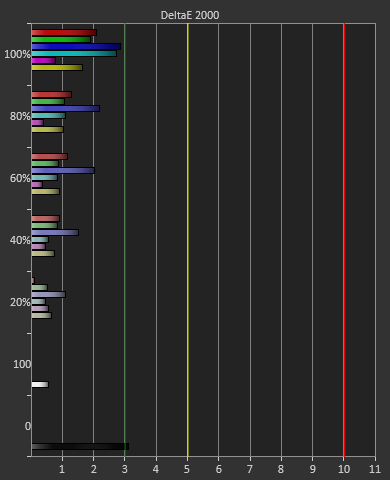
Saturations are much like they are on the last calibration, with 100% having the largest error and the numbers falling from there. 100% numbers are harder to correct since those saturations might be lacking luminance or saturation, which can’t be corrected. If a saturation below 100% is lacking saturation, we can increase that to compensate, which will reduce error, but that can’t be done with the 100% values.
Overall the sRGB target calibration is also very good, with a couple issues that came up. The biggest concern to me is that the contrast ratio drops so much, which will lead to a flatter, more washed-out image in appearance, but I didn’t see a way to correct it in several more calibration attempts.



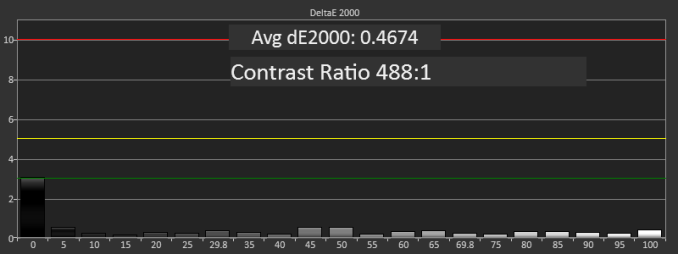










79 Comments
View All Comments
ViperV990 - Monday, June 17, 2013 - link
I'm not seeing any mentions of Lightboost (strobing backlight). IMO that is the most important selling point of this monitor. If you think the differences between 60Hz to 120Hz is huge, you'll be blown away by the differences between Lightboost on and off.ViperV990 - Monday, June 17, 2013 - link
If you're not familiar with Lightboost, this is a good place to start reading up:http://www.blurbusters.com/zero-motion-blur/lightb...
A5 - Monday, June 17, 2013 - link
Strobing backlight is the same thing "240 Hz" LCD TVs use to achieve their effect.Is the difference noticeable in anything besides specifically designed motion resolution tests?
Considering most games have motion blur shaders on these days anyways, I hardly see the point.
chizow - Monday, June 17, 2013 - link
No, it's not the same thing as 240Hz LCD TVs, instead of counting an inserted black frame or interpolated frame as a new "frame" to accomplish 240Hz, the backlight pulse ONLY strobes when an actual new frame is ready to be displayed, resulting in MUCH less image blur while allowing intermediate or transitional frames to clear.So instead of a constantly lit, muddy picture full of transitional ghosting and image retention, you get a crisp, true 120Hz image that pulses double-bright only when a true, new frame is ready to be displayed. Really a huge difference, it's why many fast-paced gamers won't go back to anything else but a 120Hz LightBoost panel, despite some of the trade-offs like 1080p limitation, TN panels etc.
Galford007 - Tuesday, June 18, 2013 - link
@A5, @Chizow:I initially thought this "lightboost" thing was a gimmick but I recently bought an ASUS 144hz lightboost-capable monitor (VG248QE, ~$300 on Newegg) and I'm now a true believer. It's capable of 3D but I prefer to use it in 2D lightboost mode. There ARE some tradeoffs such as loss of color accuracy and brightness, but it looks AMAZING, especially in games like Battlefield 3. In order to get the full effect, you need to match in-game FPS with the refresh rate, so even with a GTX 580 I have to turn BF3 settings to low and 100Hz. The graphics still look pretty good but it's worth the tradeoff IMO. I'd definitely recommend to check out the Blurbusters site for more info on the technology (as ViperV990 suggested). Basically this "lightboost" thing is a happy accident, but I'm sure it'll gain traction soon.
chizow - Tuesday, June 18, 2013 - link
Oh and blur shaders are a huge part of the problem, designed to cover up the muddy ugliness that is the norm with 60Hz non-LightBoost monitors. You'll want to turn all that crap off if you're using a 120Hz panel with LightBoost, if you value a clear, fluid image anyways.mdrejhon - Tuesday, June 18, 2013 - link
TFTCentral's Motion Blur Reduction Backlights (Including LightBoost)http://www.tftcentral.co.uk/articles/motion_blur.h...
They said that LightBoost outperformed all scanning backlights they have ever tested.
A good 60Hz vs 120Hz vs LightBoost image comparision is:
http://www.blurbusters.com/faq/60vs120vsLB
There's also a large LightBoost FAQ at:
http://www.blurbusters.com/zero-motion-blur/lightb...
Also, see the improved Battlefield3 score graphs at:
http://www.blurbusters.com/zero-motion-blur/testim...
You will notice that about 20% of amazon.com customer reviews for the ASUS VG248QE monitor (popular LightBoost monitor) have rave reviews about the LightBoost motion blur elimination. Go check out the rave LightBoost reviews:
http://www.amazon.com/VG248QE-24-Inch-Screen-LED-l...
Within that webpage, hit Control+F and find "LightBoost" in all the Amazon customer reviews!
mutantmagnet - Monday, June 17, 2013 - link
I clicked this article just to see if they were going talk about this as well. They talk about sacrificing color correction for smoother gameplay as a mundane thing which isn't the case.cheinonen - Tuesday, June 18, 2013 - link
I've been testing Lightboost today after reading the comments and will go in and add some commentary on it. Using lightboost for 2D is undocumented (at least as far as BenQ is involved) and requires some messing around with settings, and never came up in my discussions with BenQ as something to be aware of with the display. I didn't notice any commentary on it online until now either, which is how it didn't get mentioned.Also, I have no idea how the stats didn't make it into the review, that's just a dumb mistake on my part that needs to be remedied here really quick.
mdrejhon - Tuesday, June 18, 2013 - link
BTW, great to recognize the attention needed because LightBoost apparently now sells a significant fraction of 120Hz monitors ever since the extreme enthusiast community figured out how to use it (without needing 3D).Some good news -- ToastyX is developing a new LightBoost utility (I'm beta testing) that makes it easy to enable/disable. No inf/reg files -- just an easy utility. Finally, it will be easy to enable/disable LightBoost -- with a hotkey shortcut! -- even on multiple monitor setups.
Some tips:
- If you don't have a Titan/780, then Lightboost often benefits older games a lot more (try source engine games, Quake Live, test with both VSYNC ON, and with VSYNC OFF), as it behaves like a 120Hz CRT and needs 120fps to make it sing.
- XL2720T Lightboost color seems better with drivers 320.18
- For picture adjustments, see LightBoost FAQ at http://www.blurbusters.com/zero-motion-blur/lightb...
- I've sent you an email with a link to a new motion test